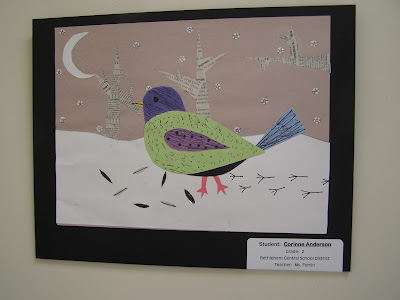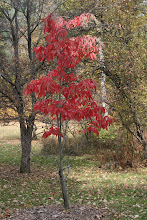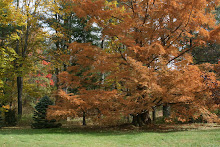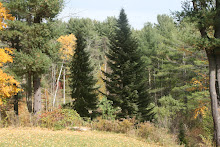Tuesday, November 26, 2013
ARBORETUM TOURS NOW ON YOU--TUBE
Snow and freezing weather got you stuck indoors? Take a John Abbuhl led tour of Pine Hollow Arboretum on YouTube anytime of the year. Enjoy the images of the Arboretum while learning more about the natural history and individual trees on the grounds. Use the link below or go to the arboretum website home page (pinehollowarboretum.org) and click on the Pine Hollow Arboretum Video Tours heading under "Links". Enjoy!
Wednesday, November 20, 2013
Channel 13 News Interviews John Abbuhl About Pine Hollow Arboretum
Phil Bayly of Sunday Forum 13, Channel 13 News interviews John Abbuhl about Pine Hollow Arboretum. Show is set to air Sunday, November 24 at 6:00 a.m. If you're not an early riser you can watch it from the WNYT website (www.wnyt.com) once the T.V. station posts it later that day. Look for it under the Forum 13 heading off the home page.
Congratulations John and thank you Helen Figge for making this happen!
Congratulations John and thank you Helen Figge for making this happen!
Sunday, September 1, 2013
BIRD WATCH AT PINE HOLLOW ARBORETUM SEPTEMBER 7, 2013
The Pine Hollow Arboretum is happy to announce that we have partnered up with the Audubon Society of the Capital Region for our first bird watch which will take place on Saturday, Sept. 7, 2013 @ 9:00 a.m. at the Visitor Center. Craig Thompson, Audubon member and recently retired director of Five Rivers Environmental Education Center will lead the walk around the arboretum and will teach us techniques about finding and identifying birds. He will also answer questions you may have about attracting birds to your own yard. Craig recommends bringing along a notebook and pencil to jot down notes and identifiable bird features so you can look them up in a bird book afterwards. This event is free and open to the public. Please bring binoculars if you have them but if you don't they have a some to share. Also, make sure to wear long, comfortable pants and closed toe shoes. We will have some breakfast treats and beverages as well. **Please note, if there is a steady rain on the morning of the event we will have to reschedule.**
Also, during the month of September, the Bethlehem Public Library will be showing artwork created by our very own members and friends who have been artistically inspired by their visits to the arboretum. There will be over 30 works of art displayed including photographs, oil and acrylic paintings and drawings. It is something you will not want to miss! The work will be on display starting Tuesday, September 3, 2013 during library hours.
We hope to see you soon and thank you for your continued supportrday, Sept. 7 @ 9:00 a.m. at the Visitor Center. Craig Thompson, Audubon member and recently retired director of Five Rivers Environmental Education Center will lead the Craig recommends bringrt
Tuesday, July 9, 2013
ARTWORK BY BETHLEHEM CENTRAL STUDENTS HANGING-OUT AT PINE HOLLOW ARBORETUM
We are fortumate to have some of the art work from the Bethlehem Central School District hanging in our Visitors Center for the summer. The art works are from a cross section of the School grades and in a variety of styles. The Visitors Center is open on weekends from 10 - 4 for you to enjoy . A good thing to do on a rainy day!
Students with work available to view are:
Calla Meyer, Zoey McCarthy, Emma Edgar,
Kamryn Lezatte, Anna Kranson, Lilah Chase,
Camilo Ibanez-Granados, Emily Mueller,
Satjiv Kanwar, Corinne Anderson,
Catherine Jennings, Tressa Hornbeck,
Patrick Lenden, Larissa Engel-Flores,
Olivia Fottrel, Eliana Sanders,
Mikeala Arena, Melissa Cathone.
A sample of their wonderful work is posted below.
Calla Meyer
Corinne Anderson
Patrick Lenden
Tressa Hornbeck
Students with work available to view are:
Calla Meyer, Zoey McCarthy, Emma Edgar,
Kamryn Lezatte, Anna Kranson, Lilah Chase,
Camilo Ibanez-Granados, Emily Mueller,
Satjiv Kanwar, Corinne Anderson,
Catherine Jennings, Tressa Hornbeck,
Patrick Lenden, Larissa Engel-Flores,
Olivia Fottrel, Eliana Sanders,
Mikeala Arena, Melissa Cathone.
A sample of their wonderful work is posted below.
Calla Meyer
Corinne Anderson
Patrick Lenden
Tressa Hornbeck
Wednesday, June 12, 2013
SIGN IN PLACE FOR PINE HOLLOW ARBORETUM
Anyone driving on New Scotland Ave. in Singerlands has now the chance to see directions to Pine Hollow Arboretum on the signpost marking the intersection of New Scotland Ave and Maple Avenue. We hope that many who have said they knew we existed but did not know where will come across our sign and make the turn. There is a sign marking the Arboretum and parking information off of Maple Ave. as well. Pine Hollow Arboretum is open to the public every day from dawn to dusk.
Pine Hollow Arboretum volunteer, Jerry Deighan was instrumental in getting the sign in place.
Thanks to him for his help.
-- Alan Casline
Pine Hollow Arboretum volunteer, Jerry Deighan was instrumental in getting the sign in place.
Thanks to him for his help.
-- Alan Casline
Monday, June 3, 2013
SUN AND RAIN AT PINE HOLLOW ARBORETUM
The 2013 season is moving along into June with a past week of rain showers, hail storms, thunder and lightening mixed with periods of blazing hot sun. All of the rain water has the ponds filled and ditches running and a few low areas too wet to walk about in. No significant wind damage has been reported at Pine Hollow Arboretum and the moisture has been good for our new tree plantings and understory growth. It is a green environment at the arboretum these days. Figure out how to dress for the weather (your guess is as good as mine) and stop by for a June visit. here are some photos from my June 2, 2013 visit.
--- Alan Casline
--- Alan Casline
Monday, April 22, 2013
Sunday, May 5th for our 2013 Open House
April 22, 2013
Dear Members & Friends,
Each season brings its own beauty to the Pine Hollow Arboretum. Whether exploring the trails, taking in the blossoms, or simply relaxing, a new discovery awaits you with each visit to our 25-acre preserve. To mark the arrival of spring, we invite our members and friends to join us to celebrate nature’s renewal on Sunday, May 5th for our 2013 Open House from 1:00 to 4:00 p.m. at 16 Maple Avenue in Slingerlands for walking tours, family fun and refreshments.
Our Open House will feature a magnificent display of magnolias & azaleas, which bloom throughout the month of May. Dr. John Abbuhl will be on hand to lead a tour of the grounds. A self-guided tour is available to those who wish, on their own, to explore the trails, groves and 12 wild life ponds. This season, we will add over 50 new plants to the 3,350 trees in the collection. We are open dawn to dusk for visitors to enjoy the longer days.
Experience the Arboretum, become a supporting member, or renew at your current expiration date. Your contributions support proper care and upkeep of the grounds and environmentally conscientious preservation of the horticultural collection.
Enjoy the peace, tranquility and especially, the trees. We look forward to a wonderful season, and hope that you will drop by for our Open House on May 5th and experience for yourself the ways in which your support helps sustain “trees in a natural environment”.
Sincerely,
Dr. John W. Abbuhl
Founder
Wednesday, March 20, 2013
FIRST DAY OF SPRING
Still in winter's grip. The first day of Spring came to Pine Hollow Arboretum with a coating of sticky snow and only a few occasional breaks in clouds to bring sun to the fields. A pleasant day for a walk on the grounds with surprising white snowball tree-flowers and shadows on the snow that were identifiable by genius and species. These photos were all taken on a late morning walk on March 20, 2013
--Alan Casline click on photos to enlarge them
snow field for walking
The cultivation of trees is the cultivation of the good,
the beautiful and the ennobling in man.
-- J. Sterling Morton
Acts of creation are ordinarily reserved for gods
and poets.
To plant a pine, one needs only a shovel.
--- Aldo Leopold

snow flowers look like white magnolias
--Alan Casline click on photos to enlarge them
snow field for walking
The cultivation of trees is the cultivation of the good,
the beautiful and the ennobling in man.
-- J. Sterling Morton
Acts of creation are ordinarily reserved for gods
and poets.
To plant a pine, one needs only a shovel.
--- Aldo Leopold

snow flowers look like white magnolias
Tuesday, March 12, 2013
Human Health And Tree Health Go Together
SOME GOOD NEWS AND SOME BAD NEWS
Karen Engel, New York State Department of Environment Conservation Green Infrastructure Coordinator, has my name on an e-mailing list which sends me posts which are always interesting to look at. It often goes too far afield to be of use at Pine Hollow Arboretum but still is nice as it shows impressive activity through-out New York State and the Northeast. She sent some information recently that seems to fit our efforts here and reinforces what many of us tree planters have known intuitively. Research published January 2013 in the American Journal of Preventive Medicine suggests that tree loss from the spread of the emerald ash borer is associated with increased mortality related to cardiovascular and lower-respiratory-tract illness. The U.S. Forest Service study collected data in nearly 1,300 counties in 15 states over 18 years. A short article by Alliance for Community Trees summarizes the research and helps to show the implications. The findings support all our efforts to preserve and enhance the living environment. The article is titled: New Research: Trees Prove Vital to Human Health. It is good that such a large-scale study has been conducted and points to a welcome conclusion. It is bad, however, that the Emerald Ash Borer (EAB) , a beetle that kills ash trees, is a proxy for tree loss.
There are hundreds of ash trees at Pine Hollow “if you count the small ones”, Arboretum founder and tree planter John Abbuhl said. They are predominately Northern White Ash ( Fraxinus Americana) and Green Ash (Franxinus pennsylvanica) which prefers wetter areas. Where ever there is a clear untended area at the Arboretum seedling ash trees will appear. The largest Northern White Ash at Pine Hollow Arboretum has a three foot through trunk at its base and is found in the western corner of the arboretum at the far end of the Magnolia Field. The largest Green Ash is two foot through and is found just west of the All Purpose Swamp. The ash is related to the olive tree. John Abbuhl said that in an evolutionary sense it is one of the more of recent species. The Mountain Ash is not an ash. It is named Mountain Ash because its leaves look like ash leaves.
Karen Engel, New York State Department of Environment Conservation Green Infrastructure Coordinator, has my name on an e-mailing list which sends me posts which are always interesting to look at. It often goes too far afield to be of use at Pine Hollow Arboretum but still is nice as it shows impressive activity through-out New York State and the Northeast. She sent some information recently that seems to fit our efforts here and reinforces what many of us tree planters have known intuitively. Research published January 2013 in the American Journal of Preventive Medicine suggests that tree loss from the spread of the emerald ash borer is associated with increased mortality related to cardiovascular and lower-respiratory-tract illness. The U.S. Forest Service study collected data in nearly 1,300 counties in 15 states over 18 years. A short article by Alliance for Community Trees summarizes the research and helps to show the implications. The findings support all our efforts to preserve and enhance the living environment. The article is titled: New Research: Trees Prove Vital to Human Health. It is good that such a large-scale study has been conducted and points to a welcome conclusion. It is bad, however, that the Emerald Ash Borer (EAB) , a beetle that kills ash trees, is a proxy for tree loss.
Researchers analyzed demographic, human mortality, and forest health between 1990 and 2007. Geoffrey Donovan, a research forester involved with the study, said “There’s a natural tendency to see our findings and conclude that, surely, the higher mortality rates are because of some confounding variable, like income or education, and not the loss of trees but we saw the same pattern repeated over and over in counties with very different demographic make-ups.” The researchers found those that lived in areas infested by the emerald ash borer and impacted by ash tree death “suffered from an additional 15,000 deaths from cardiovascular disease and 6,000 more deaths from lower respiratory disease when compared with uninfected areas. The association linking tree and human health is significant when found in such a large-scale study.
The emerald ash borer is responsible for the loss of 100 million trees in the eastern and midwestern United States since its first discovery near Detroit, in 2002. The insect threatens the entire North American Fraxinus genus. The green ash and the black ash trees are preferred. White ash is also killed rapidly, but usually only after green and black ash trees are eliminated. EAB has an eleven year life cycle and most infected trees die two to four years after being infected. Where this happens there are landscapes of dead ash trees because the trees all die at the same time. Dealing with the infested dead branches and trunk wood is a problem all in itself. The New York State Department of Environmental Conservation announced in 2009 that the emerald ash borer was recently discovered for the first time within the borders of New York State, in the Cattaraugus County town of Randolph. In October 2011 the emerald ash borer was found in Selkirk, Albany County only approximately ten to fifteen miles distant from Pine Hollow Arboretum. Currently we had no signs of EAB infestation at Pine Hollow Arboretum.
There are hundreds of ash trees at Pine Hollow “if you count the small ones”, Arboretum founder and tree planter John Abbuhl said. They are predominately Northern White Ash ( Fraxinus Americana) and Green Ash (Franxinus pennsylvanica) which prefers wetter areas. Where ever there is a clear untended area at the Arboretum seedling ash trees will appear. The largest Northern White Ash at Pine Hollow Arboretum has a three foot through trunk at its base and is found in the western corner of the arboretum at the far end of the Magnolia Field. The largest Green Ash is two foot through and is found just west of the All Purpose Swamp. The ash is related to the olive tree. John Abbuhl said that in an evolutionary sense it is one of the more of recent species. The Mountain Ash is not an ash. It is named Mountain Ash because its leaves look like ash leaves.
The colorful Asian beetle that causes so much destruction is an unwelcome visitor. One that we are on the look-out for.
Thursday, January 3, 2013
Why Evergreens are Green in Winter – Winter Photosynthesis
When
you look off the back patio at the arboretum during the winter months it’s such
a different scene then during the spring, summer or fall because most of the
leaves are off the trees. Not only can
you see farther down into the property from the same vantage point but what really
stands out to me are the highlights of green trees scattered throughout the
property. We all
know that when the seasons change and it starts to get cold and the days get
shorter deciduous trees automatically cut off connections to their leaves and
stop performing photosynthesis in order to save energy for the upcoming winter
months. But some plants and trees keep
their leaves all winter and they stay green.Trees
like evergreens and conifers continue to stay green all winter
because they have evolved special adaptions to survive the cold climate where
they grow.
First, these trees have
needles rather than leaves. The needles
are a way of protecting their foliage all year round. Snow easily falls off them. The shape of the needle and its waxy coating
is also designed to conserve water and minimize evaporation. These trees feed themselves all winter by
keeping chlorophyll in their needles by using smaller amounts of energy it
produces during the winter. The
chlorophyll is the chemical that makes photosynthesis possible and what causes
the needles to look green. Plants that
perform winter photosynthesis spend time during the spring and summer storing
energy. In simple terms, during the coldest
months, evergreens convert these starch cells back to simple sugars that can be
used to produce energy and food for the plant system, or to provide energy for
new growth in the spring.
Also, evergreens
are able to conduct photosynthesis in winter because the cells in the needles
are protected by a type of self-made antifreeze that is carried in the tree
sap. The cold temperatures and lack of
sunlight cause the photosynthesis process to occur more slowly and it is not as
efficient as warm weather photosynthesis which is why some needles end of
falling off the tree but many do not.
If you want to see
some winter photosynthesis in action visit the arboretum and see what nature
has to offer. The arboretum grounds are
open all year round. Happy New Year!
--- Sue Abbuhl
Subscribe to:
Comments (Atom)




































